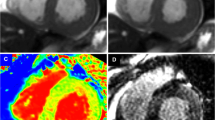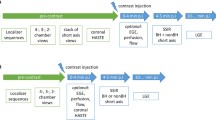Abstract
To establish cardiac MRI as a tool for noninvasive evaluation of activation patterns, 10 healthy volunteers were examined by cine segmented turboFLASH imaging sequences. Sequence modifications for low signal blood-pool appearance were applied, i.e., bilateral spatial saturation for segmented turboFLASH imaging. Pixelwise calculation of first-harmonic Fourier phase values (displayed as color-encoded maps) reveal either anterior septal or left ventricular free-wall sites as areas of earliest phase spreading towards posterior paraseptal sites in segmented turboFLASH scans. Phase scatter is lower in unsaturated than spatially presaturated segmented turboFLASH studies. Phase standard deviation in areas of endocardial displacement is higher in basal than apical slice positions in these scans. Early results indicate that first-harmonic Fourier phase analysis of cardiac-segmented turboFLASH MRI cine studies may provide a tool for noninvasive studies of cardiac activation sequence.
Similar content being viewed by others
References
Scher AM, Spach MS (1979) Cardiac depolarization and repolarization and the electrocardiogram. In Berne RM (Ed.),Handbook of Physiology, The Cardiovascular System, Vol. 1. Bethesda: American Physiological Society, pp. 357–392.
Lewis T, Feil HS, Strout WD (1918) A polymyograph and a comparison of the contraction and excitation waves in the mammalian auricle.Heart 7: 131–155.
Eyster JAE, Meek WJ, Goldberg H (1940) The relation between electrical and mechanical events in the dog's heart.Am J Physiol 131: 760–767.
Adam WE, Geffers H, Kampmann H, Bitter F, Strauch M (1977) Regional myocardial motility as evaluated by analysis of “gated blood pool” data.Z Kardiol 66: 545–555.
Höhne KH, Obermöller U, Riemer M, Witte G (1984) Fourier domain techniques of digital angiography of the heart. IEEE Transactions onMI 3: 62–67.
Weismüller P, Clausen M, Henze E, Weller R, Mayer U, Osterhues H, Richter P, Kochs M, Adam WE, Hombach V (1990) Lokalisation Vorzeitiger und Ektoper Ventrikulärer Erregung Mittels einer Neuen Nuklearmediz-inischen Schichttechnik.Z Kardiol 79: 529–534.
Kücherer HF, Abbott JA, Botvinick EH, Scheinman ED, O'Connell W, Scheinman MM, Foster E, Schiller NB (1992) Two-dimensional echocardiographic phase analysis.Circ 85: 130–142.
Semelka RC, Tomei E, Wagner S, Mayo J, Kondo C, Suzuki J-I, Caputo GR, Higgins CB (1990) Normal left ventricular dimensions and function: interstudy reproducibility of measurements with cine MR imaging.Radiology 174: 763–768.
Chien D, Merboldt KD, Hänicke W, Bruhn H, Gyngell MI, Frahm J (1990) Advances in cardiac applications of subsecond FLASH MRI.Magn Res Imag 8: 829–836.
Chien D, Edelman RR (1991) Ultrafast imaging using gradient echos.Magn Res Quart 7: 31–56.
De Roos A, Kundel HL, Joseph PM, Doornbos J, Kressel HY (1990) Variability of myocardial signal on magnetic resonance images.Invest Radiol 25: 1024–1028.
Duewell S, Koch M, Wüthrich R, Stöhr S, Jenni R, v Schulthess GK (1992) Quantitative MR signal behaviour in cardiac cine loops as a function of heart rate.J Magn Res Imag 2: 75–83.
Matthaei D, Haase A, Henrich D, Dühmke E (1992) Fast inversion recovery Tl contrast and chemical shift contrast in high-resolution snapshot FLASH MR images.Magn Res Imag 10: 1–6.
McDonald KM, Parrish T, Wennberg P, Stillman AE, Francis GS, Cohn JN, Hunter D (1992) Rapid, accurate and simultaneous noninvasive assessment of right and left ventricular mass with nuclear magnetic resonance imaging using the snapshot gradient method.J Am Coll Cardiol 19: 1601–1607.
Atkinson DJ, Edelman RR (1991) Cineangiography of the heart in a single breathhold with a segmented turboFLASH sequence.Radiology 178: 357–360.
Mansfield P, Chapman B, Stehling MK (1988) Cardiac Phase Mapping in Real-Time NMR Imaging [Abstract].Proceedings, Society of Magnetic Resonance in Medicine Annual Meeting, San Francisco, p. 11.
Sakuma H, Fujita N, Foo TKF, Caputo GR, Nelson SJ, Hartiala J, Shimakawa A, Higgins CB (1993) Evaluation of left ventricular volume and mass with breath-hold cine MR imaging.Radiology 188: 377–380.
Pavel DG, Briandet PA (1982) Quo vadis phase analysis.Clin Nucl Med 11: 564–575.
Botvinick EH, Dae MW, O'Connell JW, Scheinman MM, Hattner RS, Faulkner DB (1987) First harmonic Fourier (phase) analysis of blood pool scintigrams for the analysis of cardiac contraction and conduction. In Gerson MC,Cardiac Nuclear Medicine, McGraw Hill, pp. 109–147.
Botvinick E, Dunn R, Frais M, O'Connell W, Shosa D, Herfkens R, Scheinman M (1982) The phase image: its relationship to patterns of contraction and conduction.Circ 65: 551–560.
Botvinick EH, Frais MA, Shosa DW, O'Connell JW, Pacheco-Alvarez RA, Scheinman M, Hattner RS, Morady F, Faulkner DB (1982) An accurate means of detecting and characterising abnormal patterns of ventricular activation by phase image analysis.Am J Cardiol 50: 289–298.
Frahm J, Merboldt KD, Bruhn H, Gyngell ML, Hänicke W, Chien D (1990) 0.3-Second FLASH MRI of the human heart.Magn Res Med 13: 150–157.
Henrich D, Haase A, Matthaei D (1990) 3D-snapshot FLASH NMR of the human heart.Magn Res Imag 8: 377–379.
Matthaei D, Haase A, Henrich D, Dühmke E (1990) Cardiac and vascular imaging with an MR snapshot technique.Radiology 177: 527–532.
Matsuda T, Yamada H, Kida M, Sasayama S (1994) Is 300 msec too long for cardiac MR imaging? Feasibility study demonstrating changes in left ventricular cross-sectional area with use of single-shot turboFLASH imaging.Radiology 190: 353–362.
Author information
Authors and Affiliations
Rights and permissions
About this article
Cite this article
Knollmann, F.D., Mäurer, J., Kücherer, H. et al. Cardiac activation mapping by MRI. MAGMA 4, 19–25 (1996). https://doi.org/10.1007/BF01759776
Received:
Issue Date:
DOI: https://doi.org/10.1007/BF01759776




